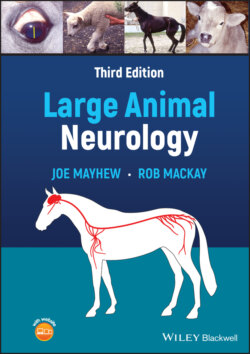Читать книгу Large Animal Neurology - Joe Mayhew - Страница 30
Head posture and movement
ОглавлениеAll normal animals maintain the head in a certain posture and maneuver it quickly and smoothly to perform acts such as prehension of food. Unilateral and asymmetric lesions involving the vestibular system consistently result in a head tilt that is characterized by the poll rotating laterally while the caudal neck and the muzzle remain, or are placed back to, the median plane. In comparison, a horse with a forebrain lesion that tends to turn to one side and to circle, usually, though not always (see Fig 33.1), to the side of the lesion, often has the head and neck deviated toward the direction of the turn. The presence of a head tilt should be evaluated for only when the muzzle and neck are held by the examiner as close to the median plane as possible and rotation of the poll and muzzle can be viewed relative to the median plane. In comparison, with a head turn as seen with forebrain disorders, the long axis of the head usually aligns on the median plane when the muzzle is gently brought back to a median position. A severe vestibular lesion can result in a significant head tilt and head and neck turn, usually both toward the side of the lesion. Animals with bilateral central or peripheral vestibular (and cerebellar) disease frequently show swinging movements of the head and neck, i.e., head and neck ataxia.
A musculoskeletal disorder, especially involving the neck, must be considered if there is any asymmetry or deviated head and neck posture. Additionally, congenitally blind horses may have abnormal head posture, including a true head tilt, along with jerky head movements, and corresponding eyeball deviations and movements. Such a syndrome may be equivalent to amblyopia in children. In addition, congenital, asymmetric strabismus in horses has been associated with a head tilt with no other evidence of vestibular involvement, and abnormal head posture can be seen in Appaloosa horses with night blindness. Particularly at the onset of a fast gait, many normal horses will hold the head and neck deviated from the median plane: perhaps more related to a reaction to a mouth bit than to speed. Painful conditions such as dental disease, forelimb and hindlimb14 lameness, and caudal cervical arthritis, and asymmetric visual acuity, can also result in abnormal head, neck and trunk positioning during exercise or at rest.
The cerebellum modulates movement of the head and limbs so that cerebellar lesions usually result in alterations in the force, speed, and range of movement of body parts including the head and neck.15 With cerebellar disease, fine control of head positioning is often lost, resulting in awkward, jerky movements. Even at rest, the lack of control is often seen as bobbing movements of the head, which can be exaggerated by increased voluntary effort. The resulting fine jerky movements of the head are called intention tremor. Such animals will overshoot when positioning their head, when moving to eat, for example. Newborn foals normally hold their head flexed slightly on the neck and move it in a jerky manner, especially in response to visual or tactile stimuli, rather resembling cerebellar dysfunction.
Animals with neck pain may hold their neck in an abnormal fixed position and be reluctant to move the head and neck. Also, diseases causing neck weakness may result in an animal carrying its head lower to the ground. Examples of this include diffuse neuromuscular weakness seen with botulism and with equine motor neuron disease. This is also but rarely seen with extensive cervical spinal cord, final motor neuron lesions involving ventral gray matter, and for example with extensive cervical myeloencephalitis. Finally, an extended head and neck posture, referred to as a star‐gazing attitude, may indicate a severe forebrain disorder such as polioencephalomalacia of ruminants and basilar empyema, and is also present with diseases causing increased extensor muscle tone, such as equine tetanus and bovine myotonia.
